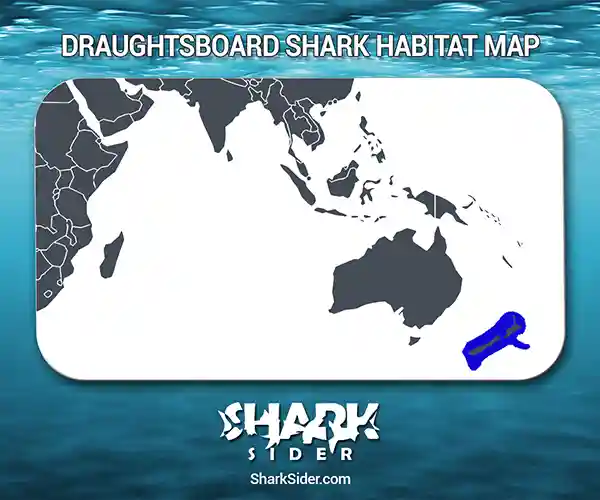The draughtsboard shark is a catshark endemic to New Zealand. It is named after the patterns on its body, which resemble a checkerboard.
Draughtsboard Shark Scientific Classification |
|
| Kingdom | Animalia |
| Phylum | Chordata |
| Class | Chondrichthyes |
| Order | Carcharhiniformes |
| Family | Scyliorhinidae |
| Genus | Cephaloscyllium |
| Scientific Name | C. isabellum |
Description
On average, these sharks are 3.3 ft long, though some specimens have reached 4.9 ft, with females growing larger than males. Its body is shaped like a spindle, starting with a broad head and ending in a thin caudal fin. If one were to observe the shark’s head, one would see a pair of oval eyes on top of it, which have spiracles behind them. The nostrils have a tiny triangular flap of skin covering them. The teeth in the upper jaw remain exposed even when the curved mouth is closed.
Draughtsboard sharks have two broad pectoral fins, a short caudal fin, and two dorsal fins lower down their bodies. The second is much smaller than the first dorsal fin, as well as the anal fin.
This shark is golden to brown from above and light when looked at from below—around 11 dark brown, irregular dorsal “saddles” alternating with blotches on its flanks, forming a checkerboard pattern.
Where do they live
Map Of The Draughtsboard Shark’s Habitat

This shark has been spotted around the coasts of New Zealand, commonly seen around the Chatham Islands, the Snares, and Stewart Island.
It is a bottom-dweller that prefers to swim in shallow waters (0 to 1,312 ft) and lives around rocky and sandy areas, staying inside reef caves.
Behavior
Hunting
Draughtsboard sharks feed on blennies, cod, crabs, gastropods, hermit crabs, innkeeper worms, krill, octopi, sand perch, sea squirts, spiny dogfish, spiny lobsters, and squids. In order to consume innkeeper worms, this shark will suck them out of their burrows.
Social
The adult males and females will live separately from each other.
Reproductive
They are oviparous, laying two eggs at a time. A draughtsboard shark egg is smooth and cream-colored. After hatching, the newborns that emerge are 6.3 inches long. Sexual maturity is observed in males at 24 inches and females at 31 inches.
Adaptations
Similar to other swell sharks, when approached by a predator, they will intake a lot of water and inflate themselves. If threatened further, they will deflate themselves, producing a sound similar to a large dog barking.
Interactions with humans
This shark is often caught as bycatch but is just as quickly released as it has no commercial value. It is durable enough to survive being out of the water for a little while. The most significant threat to this shark came from a New Zealand shark liver fishery that was active from 1988 to 1991, which recorded 74–540 tons of this shark caught annually. Once the fishery shut down, the catches fell drastically to only about 5 tons annually.
